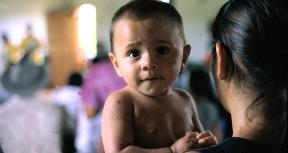An Evolving View from Income Inequality to Shared Prosperity
At the World Bank, the importance of addressing high inequality levels to achieving the vision of poverty elimination has been increasingly recognized over the past decades. Starting with the 1990 World Development Report (WDR) on poverty, various World Bank Group flagship studies and strategy documents have recognized that high levels of inequality can be an obstacle to sustained poverty reduction.
The 1990 World Development Report Poverty argues that this is especially relevant in some of the most highly unequal countries in Latin America and the Caribbean. This and many other World Bank publications have increasingly emphasized that although poverty alleviation requires growth, growth is not enough: growth must be broad-based and labor-intensive, and it must be coupled with efforts to improve the targeting and effectiveness of basic social expenditures.
The 2000/01 World Development Report Attacking Poverty, for example, concludes that attaining the international development goals will require actions not only to spur economic growth but also to reduce income inequality and make progress in two other important fronts: facilitating empowerment by developing sound and responsive public sector institutions, and enhancing security by reducing the poor’s vulnerability to various external shocks.Many of these issues were revisited in depth in the Equity and Development 2006 World Development Report
The World Bank Group has recognized the importance of avoiding growing levels of inequality to achievement of the twin goals; however, it has stopped short of considering inequality reduction a goal in itself. Continued increases in inequality, as observed in some of the larger developing countries in recent years, imply that attaining the global poverty eradication target would require growth rates that are higher than what has been historically observed.
The World Bank has thus recognized that to make progress toward the first twin goal, countries will have to implement policies and reform institutions so as to limit increases in inequality. Similarly, official World Bank documents have explicitly stated that sustained progress in achieving the second twin goal is incompatible with a steady increase in inequality. However, the World Bank has also noted that promoting shared prosperity does not necessarily imply reducing inequality in all countries at every point of time. In the event, in 2013, the World Bank Group has adopted the shared prosperity goal that defines it as growth of real income of the bottom 40 percent. While this measure is a growth and not an inequality measure, it has strengthened the Bank’s focus on inclusive growth, the bottom income deciles, and the broad development agenda that includes inequality.
The World Bank Group’s Operational and Institutional Embrace of the Shared Prosperity Goal
World Bank Group Operations:
Quality of Theory of Change in Bottom 40 Percent
Operations, by Asset-Based Framework

- Despite significant data constraints, Systematic Country Diagnostics (SCDs) are for the most part delivering on their mandate of providing an explicit analysis of constraints for boosting shared prosperity.
- Only 20 percent of the core country diagnostics, other than the SCDs, produced since October 2013, include an explicit analysis of shared prosperity issues.
- About one-half of Country Economic Memorandums do include such analysis but shared prosperity issues are much less frequently covered in public expenditure reviews.
- The most common pathways for boosting shared prosperity identified in SCDs and other relevant knowledge work are related to building the productive assets of the bottom 40 (B40) percent of the income distribution in each country and improving macro policies and institutions. Issues related to market access and transfers are less frequently featured in analytical works as priority pathways for increasing incomes of the bottom 40 percent.
- Country Partnership Framework (CPF) objectives generally do not include a clearly articulated theory of change pertaining to the B40: only for 7 percent of the objectives included in the CPFs approved since October, 2013, do CPFs describe the results chain linking World Bank interventions, context variables, and outcomes related to the bottom 40 percent.
See Chapter 2: How has the World Bank Operationalized the Shared Prosperity Goal?
Institutional Requirements:
- A review of the design of approved IFC projects between FY14 and FY15 found that only 15 percent mentioned the shared prosperity goal, but none included a clear theory of change linking project results to benefits accruing to the bottom 40 percent (or to a subset of that group).
- Understanding of the shared prosperity goal is not universal among World Bank Group staff: almost 30 percent of IBRD staff and almost 60 percent of IFC staff are not familiar with the official definition of the goal.
- Two-thirds of staff report having incorporated the shared prosperity goal in their work, especially in IBRD’s knowledge products and services but also in its lending and strategy work.
- Incorporation of the goal is much less common in IFC’s investments and advisory services, but there are ongoing new initiatives to better monitor the wellbeing of IFC project beneficiaries, including the introduction of a new ex-ante evaluation framework starting in FY18.
- More than two-thirds of staff and a number of World Bank Chief Economists believe the World Bank Group should focus more explicitly on reducing inequality, especially in opportunities (as opposed to focusing on boosting equality in outcomes).
- Besides suboptimal staff awareness, limited client interest and lack of good quality data are among the main constraints to further mainstreaming the shared prosperity goal in World Bank Group operations.
- Significant global and local partnership efforts are under way to advocate for coordinated support to boost shared prosperity and address data constraints.
- The most common channel through which staff contribute to shared prosperity goal is related to improvements in the assets of populations in the bottom 40 percent: human, physical, financial, social and natural assets.
Country Partnership Framework Objectives
and Quality of Theory of Change

Familiarity with the Official Definition
of Shared Prosperity, by Global Practice

See Chapter 3: Institutional Requirements for Implementation of the Shared Prosperity Goal
Recommendations
1. Where there are knowledge and data gaps on the characteristics of B40 populations or on the drivers of B40 income growth, the World Bank (IBRD and IDA) and IFC should provide sufficient funding for analytical diagnostic work to close the knowledge gaps within the following country partnership framework cycle, and it should encourage country clients to ensure greater availability, quality and comparability of distributional data.
2. The Management of the World Bank Group institutions should ensure financed strategies and projects that explicitly aim to contribute to the shared prosperity goal also include clear descriptions of the results chains linking the respective interventions to outcomes for B40 populations.
3. World Bank Group–financed strategies and projects that explicitly aim at contributing to the shared prosperity goal should have clear results frameworks with indicators that permit measuring the World Bank Group’s contributions to shared prosperity outcomes.
4. For projects in which it is possible to identify the geographical location of direct beneficiaries, the WBG should monitor the extent to which the geographical distribution of beneficiaries and that of populations in the bottom 40 percent are congruent.
5. Management should ensure that operational staff across all its institutions have a clear understanding of the shared prosperity goal and possess the skills needed for effectively incorporating and tracking shared prosperity–related objectives in World Bank Group–financed strategies and projects, where relevant.


















